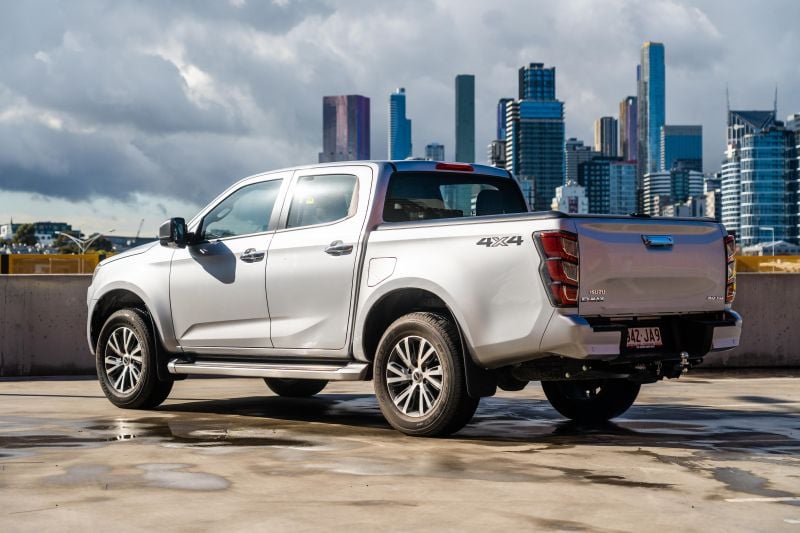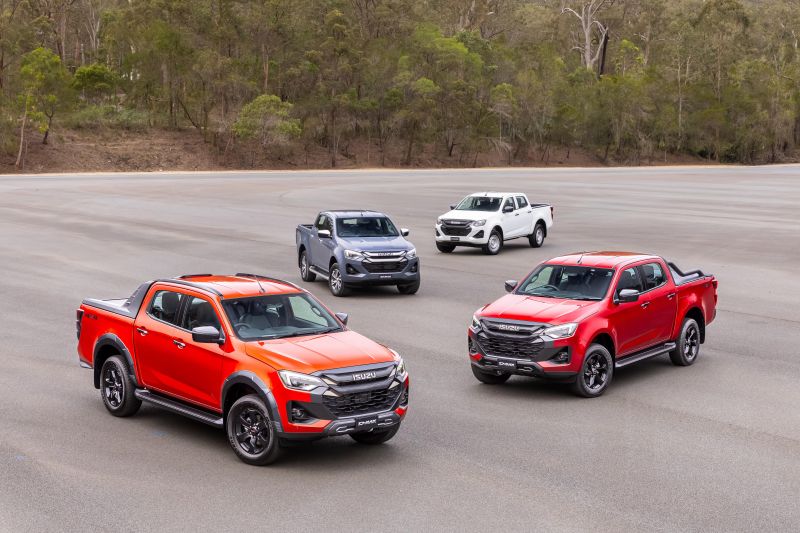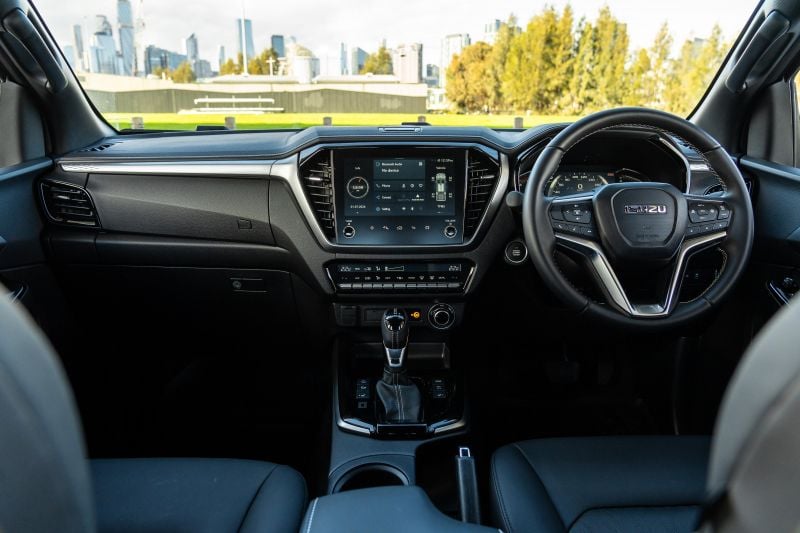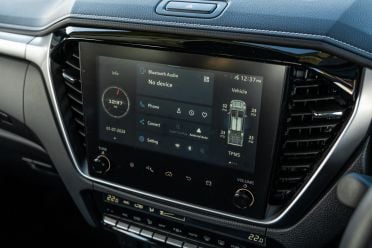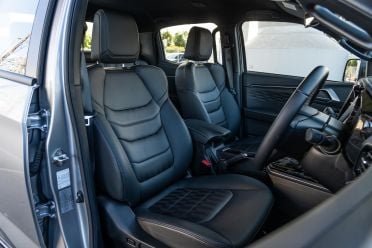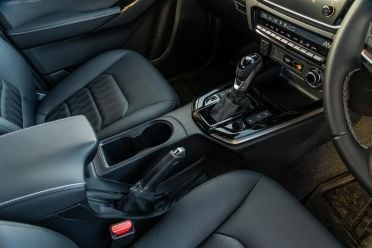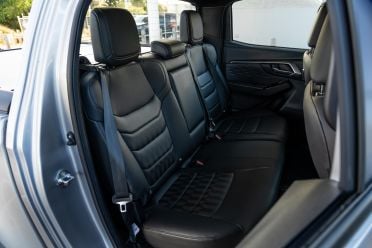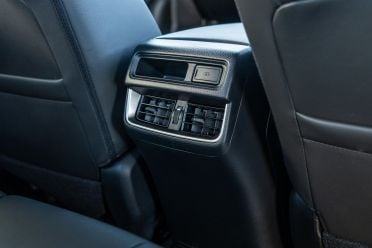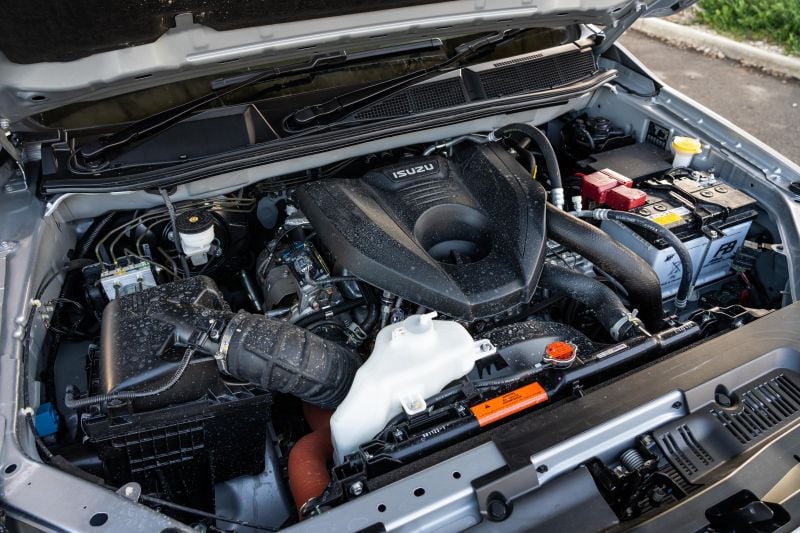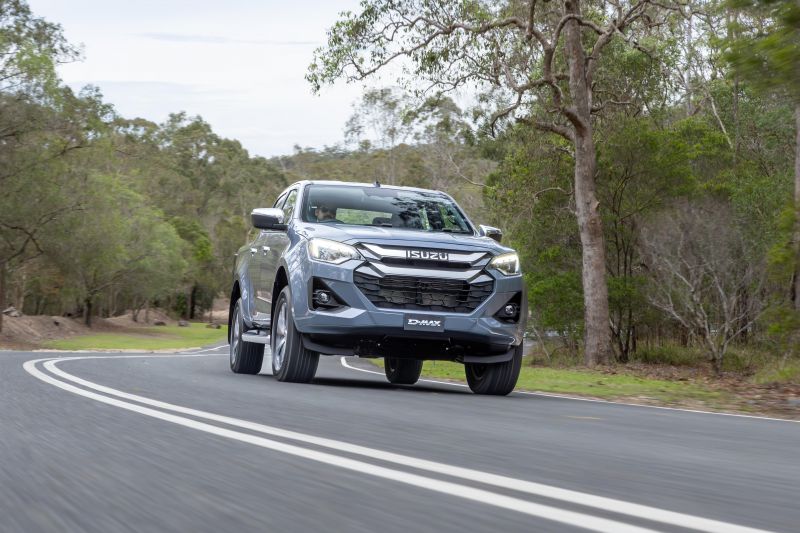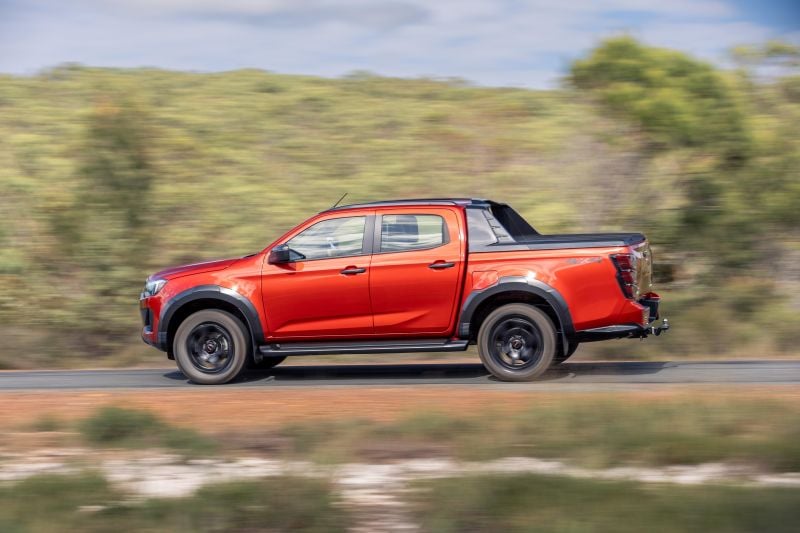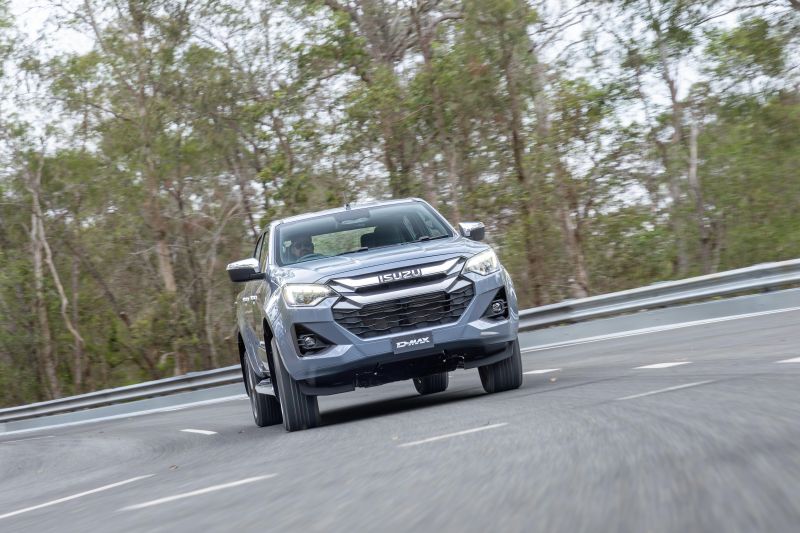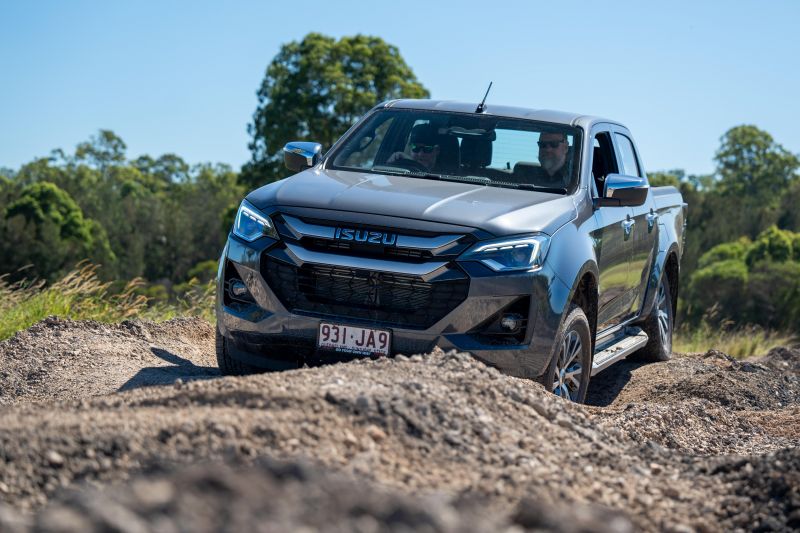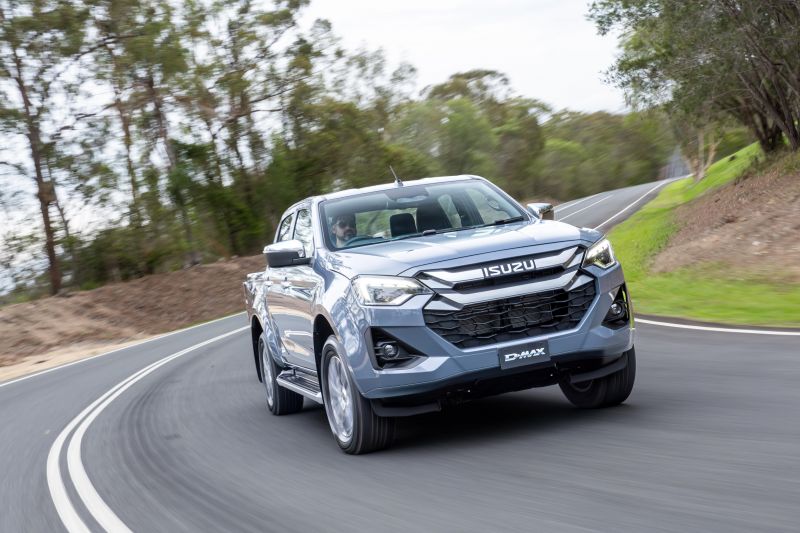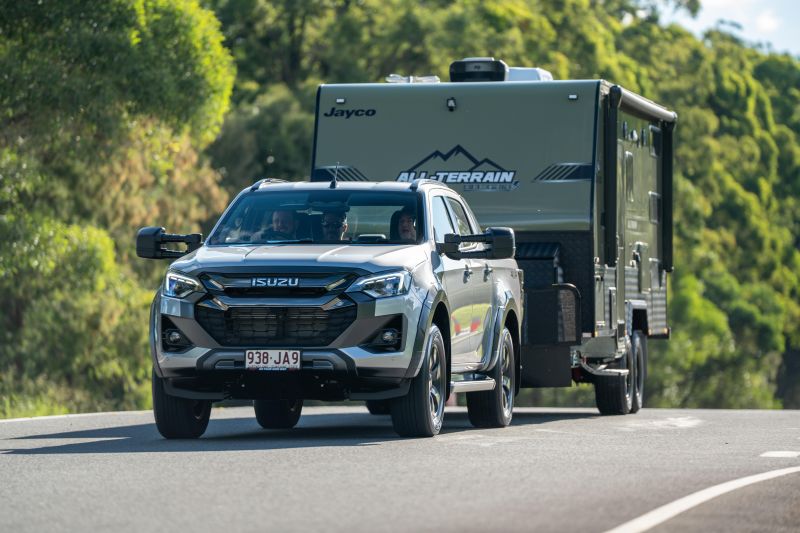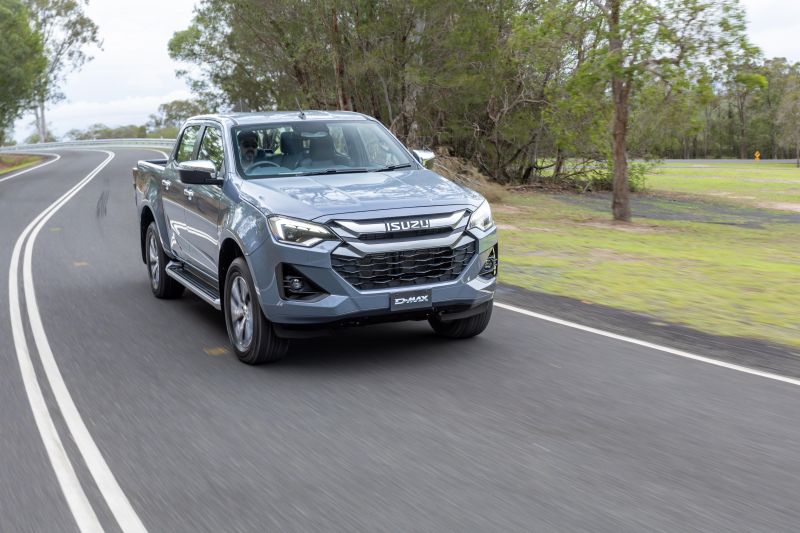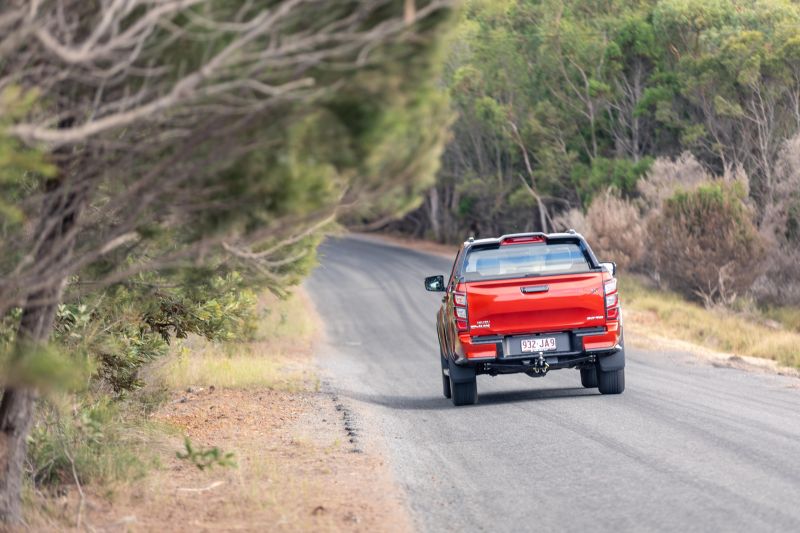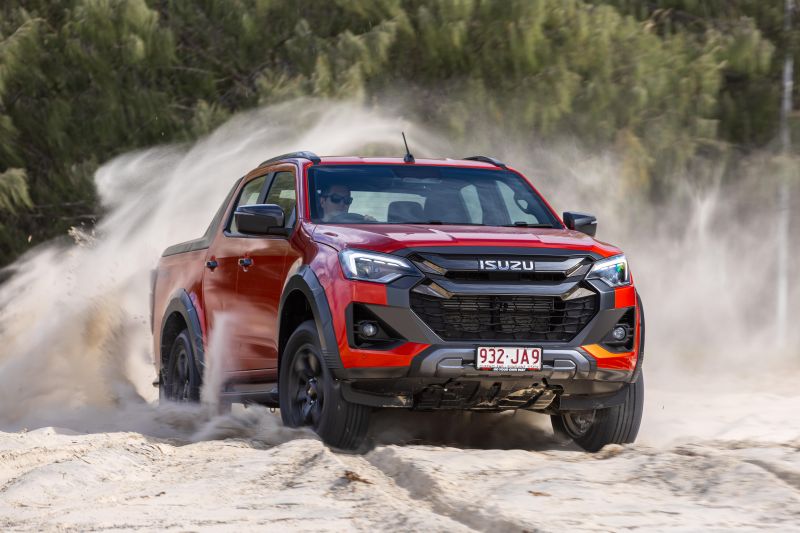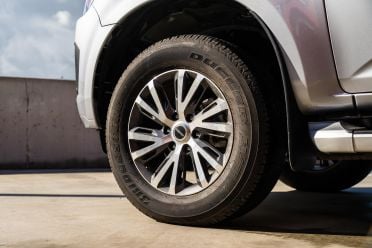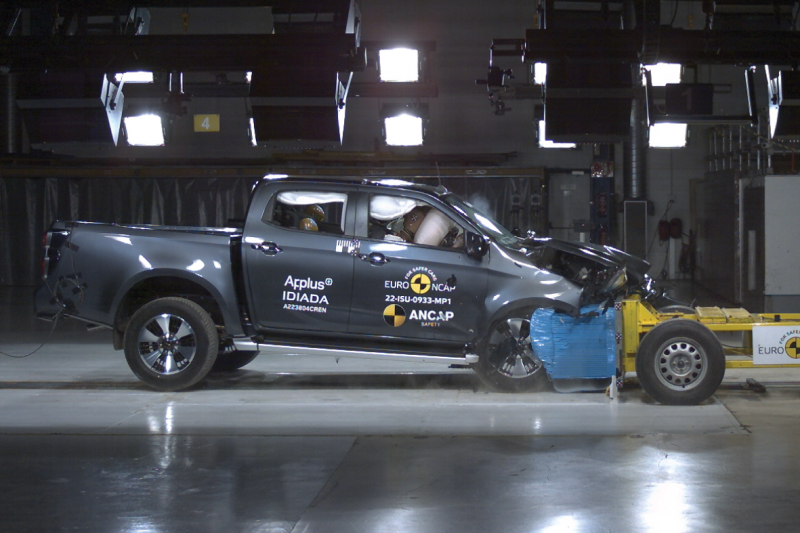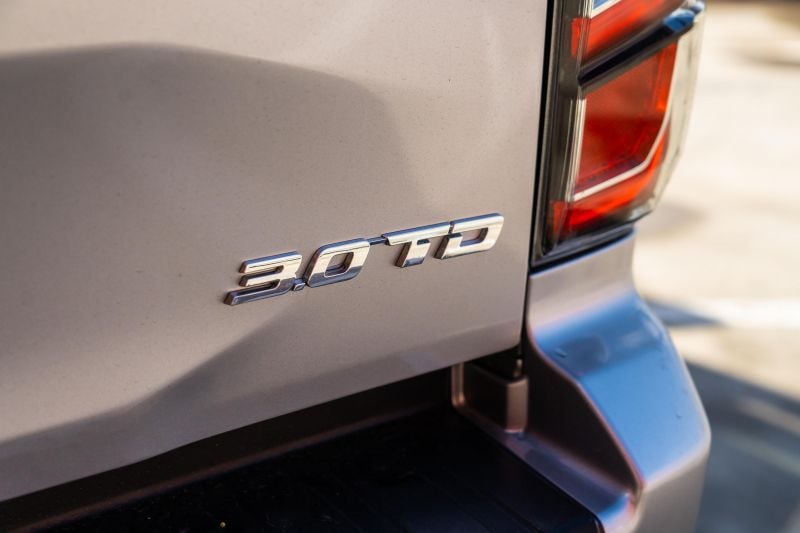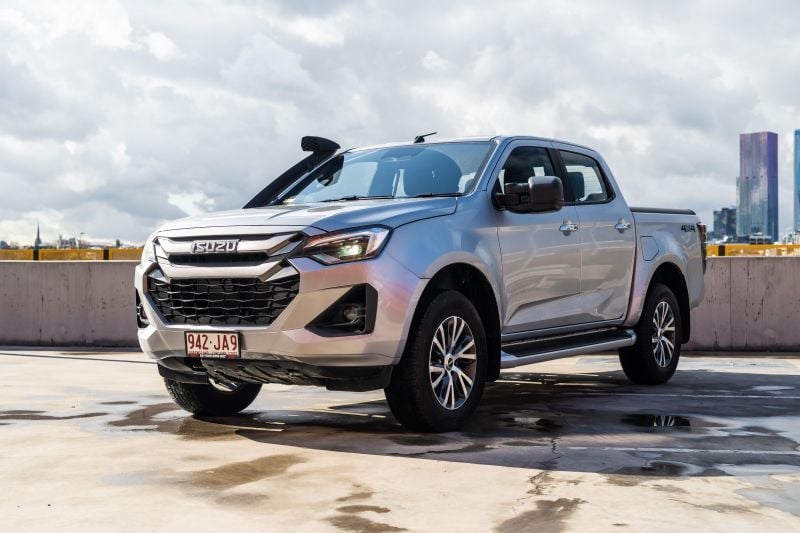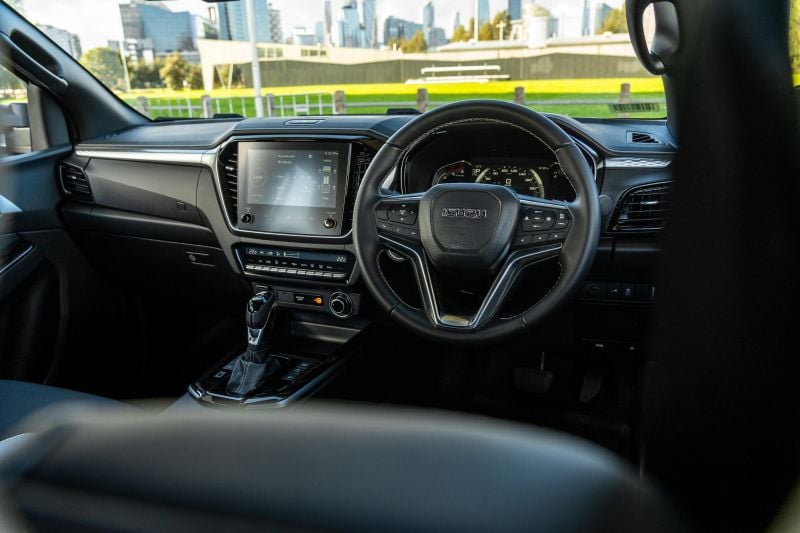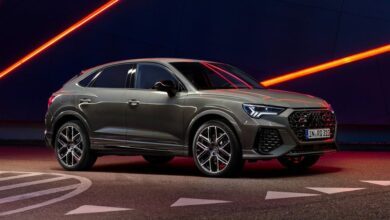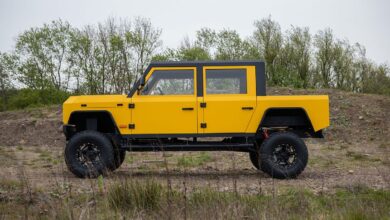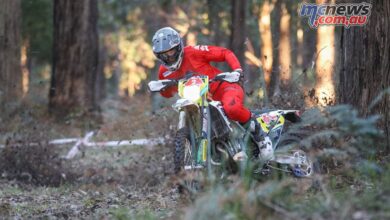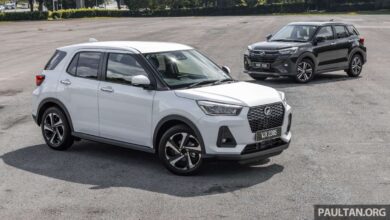2025 Isuzu D-Max review | CarExpert
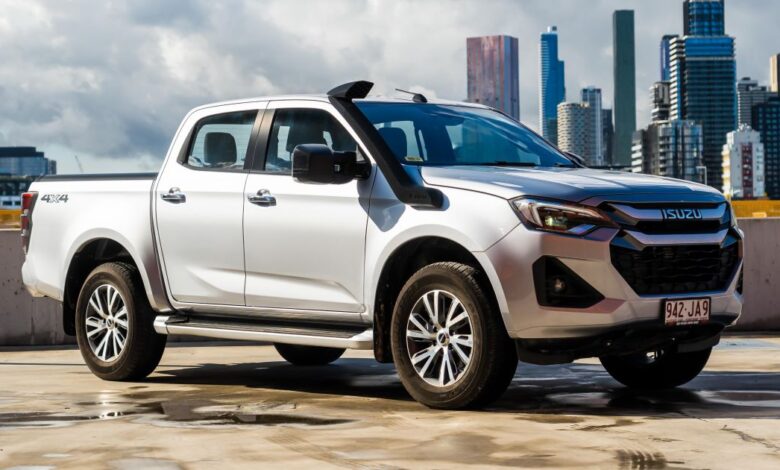
You’re looking at Isuzu’s top-selling vehicle in Australia, and there’s a good reason it holds that distinction.
For one, the Isuzu D-Max is built on a tried and tested formula. Now in its third generation, it received an update earlier in 2024 that brought refinements to things like its front fascia, bonnet, and headlights.
On the inside it received a tweaked instrument cluster and new touchscreen infotainment system with wireless Android Auto.
Additionally, off-road capability has been improved with the addition of a Rough Terrain mode on 4×4 models, which works alongside the rear differential lock for maximum traction.
There were also some safety updates that improved the function of systems that were already present.
In 2023 the D-Max was the third best-selling 4×4 ute in the country, behind only the Ford Ranger and Toyota HiLux. It’s quite sharply priced against at least one of those two, and is among the more affordable ute lineups available here right now.
To top it all off, Isuzu claims to have fixed the bump steer issue from previous models that led to premature and uneven tyre wear.
On test here is the 2024 Isuzu D-Max LS-U+, which offers some extra interior conveniences over the rest of the range and the beefier of the two powertrains on offer.
It’s ranked one rung down from the peak of the D-Max pecking order, and comes in for just over $65,000 before on-road costs. That’s less than most of its rivals, including the equivalent Ranger Wildtrak BiTurbo.
How does the Isuzu D-Max compare?
View a detailed breakdown of the Isuzu D-Max against similarly sized vehicles.

Isuzu
D-Max
How much does the Isuzu D-Max cost?
A total of 25 variants are offered, with pricing increased by up to $3000 on the year prior.
D-Max 4×2
| Model | Price before on-road costs |
|---|---|
| SX Single Cab Chassis 1.9L manual | $32,700 ($32,490 D/A) |
| SX Single Cab Chassis 1.9L auto | $34,700 |
| SX Single Cab Chassis 3.0L manual | $34,700 |
| SX Single Cab Chassis 3.0L auto | $36,700 |
| SX Space Cab Chassis 3.0L auto | $40,200 |
| SX Crew Cab Chassis 1.9L auto | $41,200 |
| SX Crew Cab Ute 1.9L auto | $42,700 |
| SX Crew Cab Chassis 3.0L auto | $43,200 |
| SX Crew Cab Ute 3.0L auto | $44,700 |
| LS-U Crew Cab Ute 3.0L auto | $54,500 |
D-Max 4×4 Cab Chassis
| Model | Price before on-road costs |
|---|---|
| SX Single Cab Chassis 3.0L manual | $42,700 |
| SX Single Cab Chassis 3.0L auto | $44,700 |
| SX Space Cab Chassis 3.0L auto | $48,200 |
| SX Crew Cab Chassis 3.0L manual | $49,200 |
| SX Crew Cab Chassis 3.0L auto | $51,200 |
| LS-M Crew Cab Chassis 3.0L auto | $54,300 |
| LS-U Crew Cab Chassis 3.0L auto | $61,000 |
D-Max 4×4 Ute
| Model | Price before on-road costs |
|---|---|
| SX Crew Cab Ute 1.9L auto | $50,700 |
| SX Crew Cab Ute 3.0L auto | $52,700 |
| LS-M Crew Cab Ute 3.0L auto | $55,800 |
| X-Rider Crew Cab Ute 3.0L auto | $59,500 |
| LS-U Space Cab Ute 3.0L auto | $59,500 |
| LS-U Crew Cab Ute 3.0L auto | $62,500 |
| LS-U+ Crew Cab Ute 3.0L auto | $65,500 |
| X-Terrain Crew Cab Ute 3.0L auto | $70,500 ($67,990 D/A) |
To see how the D-Max stacks up against its rivals, compare it using our comparison tool.
What is the Isuzu D-Max like on the inside?
All things considered, there’s really no arguing the D-Max offers a nice interior.
It’s hard to not take note of the hard plastics draped across the cabin’s main touch points, but for a practical car with commercial underpinnings it’s easy to forget you’re not in a typical SUV – unless you look behind you, of course.
First and foremost are the seats, which in this spec of D-Max are leather-accented, heated, and power-adjustable. As such, you’ll have no issues getting comfortable when you first hop in, and they make for easy hours behind the wheel.
Speaking of – that wheel is also leather-trimmed, and it’s where you’ll find a lot of the infotainment and driver assist controls. As is expected, they’re arranged in an assortment of buttons on the spokes, though they do feel a little cheap and aren’t always as responsive as perhaps they could be.
They still work as they should, and by extension there’s nothing in the cabin that doesn’t fall into place logically. Even if there is something you can’t immediately figure out, a couple of seconds spent poking and prodding will quickly give an answer you’ll easily remember as an owner.
If there was a complaint regarding layout, it’d be that the sun visor hits the rear view mirror when unfolded. That means you can’t open it all the way unless you physically move the mirror out of alignment, which seems like a bit of an oversight.
Up ahead of the wheel is a 7.0-inch digital instrument cluster, which I find a little grating in appearance. I’m not a fan of the graphics and general style here; I prefer the traditional two gauges and 4.2-inch multi-information display on lower D-Max grades.
That’s not to say you don’t get plenty of info with the upgraded system, because you do. You’ll find anything you need to know between the mix of a completely digital display and illuminated gauges for engine temperature, fuel level, and RPM – I just wish the screen’s presentation was a bit more crisp.
The same can’t be said for the infotainment system, which is situated on a 9.0-inch touchscreen. This is a solid piece of tech, and I can forgive the inclusion cheap-ish instrument cluster if I still get a quality system for music and navigation.
Its display is sharp and well laid-out with its dual tuner and volume knobs, and wireless Apple CarPlay is a nice treat. It’s offered across the range, and apart from a couple of hiccups with the initial phone hook-up it worked flawlessly during our week with the car.
I should note those hiccups were likely user error, as I had no issues at any point in the process with the lower-spec X-Rider prior to driving the LS-U+.
Below that you’ll find a substantial climate control system, which in this spec of D-Max is arranged in a line of bi-directional switches connected to a small display.
It’s really not all that different to what you’ll find in something like a Mazda, which is unsurprising given the D-Max and BT-50 are mechanical twins and share a lot of interior bits.
Again that’s a good thing for the D-Max, as it means you get a reliable and easy-to-use climate system that doesn’t rely on touchscreen or haptic controls. Additionally, there’s a traditional gear selector with a sparing selection of buttons either side.
A downside is the gloss black trim, which in a car like the D-Max is a questionable addition given the heavy-duty use it’s intended for. We know it scratches and smudges very easily, so if you’re going to be moving things in and out of the cabin regularly I’m sure it’ll start to look a bit second-hand in no time.
Otherwise there’s a mechanical handbrake, alongside plenty of storage options on the dash and centre console. You only get one dedicated cupholder for the centre console though, but there are fairly sizeable bottle holders in all four door cards.
It’s disappointing Isuzu doesn’t offer a wireless charging pad as standard, but it can be added as an option for an extra $470. It’d be slotted in ahead of the gear selector, which is normally just an area for out-of-the-way phone storage.
Our tester is also fitted with optional rubber floor mats (an extra $217), which offer improved durability and are easier to clean than their carpet counterparts if you’ve got muddy boots.
As the driver, you’re positioned in quite a commanding elevated position that offers great visibility out the front. Additionally, there is good visibility out the rear door windows for head checks, and the large rear window means it’s all too easy to keep an eye on everything around you.
There are also large extended mirrors with built-in indicators on the LS-U+, which in combination with blind-spot mirroring makes it easy to position the car on the road. The parking cameras and sensors help in tight spaces too.
Getting into the back isn’t as easy as you might like, as it’s limited by doors that don’t open to the full 90 degrees and an opening that’s on the smaller side.
To help, there are side steps running the length of the body to make it a shorter step up for both front and rear passengers. Once you’re in, it’s not an ideal place to spend time… but will do fine if you’ve got a family to transport.
The rear offers quite a high seating position, which means improved visibility but reduced head space for taller passengers. Toe and leg room is fine, but whether or not you’re comfortable will depend heavily on where the front seats are positioned.
It’s a bench seat arrangement as is expected for a dual-cab ute, though its quite firm and flat. If you’re not prepared you’ll be sliding around thanks to the leather finish, but at least there are large grab handles on the B-pillars to keep you situated.
As far as creature comforts go in the rear, Isuzu has fitted two air vents and a single USB-C outlet on the back of the centre console, while there’s also a fold-down centre armrest with two cupholders.
At the rear is the ute tub, which is appointed with tailgate assist across the range. That makes it easier to open and close the tailgate, but you’ll need to remember it still needs to be locked manually as it isn’t included in the central locking.
For comparison, the D-Max offers a tub that is more or less the same width as what’s offered with the Ranger, though its floor is more than 100mm longer but slightly shallower.
Covering it all off is a black rolling tonneau cover, which is an extra premium touch on an already very complete package.
| Dimensions | Isuzu D-Max LS-U+ |
|---|---|
| Length | 5285mm |
| Width | 1870mm excl. mirrors |
| Height | 1790mm |
| Wheelbase | 3125mm |
| Tub length | 1495mm (top) 1570mm (floor) |
| Tub width | 1530mm (maximum) 1122mm (between arches) |
| Tub depth | 490mm |
To see how the D-Max stacks up against its rivals, compare it using our comparison tool.
What’s under the bonnet?
The Isuzu D-Max is offered with a choice of two four-cylinder turbo-diesel engines: a 1.9-litre with 110kW of power and 350Nm or torque, and a 3.0-litre with 140kW and 450Nm. Our tester was fitted with the latter.
| Specifications | Isuzu D-Max LS-U+ |
|---|---|
| Engine | 3.0L 4cyl turbo-diesel |
| Power | 140kW @ 3600rpm |
| Torque | 450Nm @ 1600rpm |
| Transmission | 6-speed automatic |
| Driven wheels | Part-time four-wheel drive (2H, 4H, 4L) |
| Weight | 2110kg – kerb |
| Payload | 990kg |
| Gross vehicle mass (GVM) | 3100kg |
| Towing capacity | 750kg – unbraked 3500kg – braked |
| Gross combined mass (GCM) | 6000kg |
| Fuel economy – claimed | 8.0L/100km |
| Fuel economy – as tested | 11.9L/100km |
| Fuel tank size | 76L |
| Fuel requirement | Diesel |
To see how the D-Max stacks up against its rivals, compare it using our comparison tool.
How does the Isuzu D-Max drive?
Given what’s offered in some of its competition, the D-Max drives surprisingly well.
Dual-cab utes have been known to skittishly bang and clatter over bumps when there’s nothing loaded, but Isuzu has managed to refine the ride to a point where there’s really nothing that will have you falling out of your seat.
Of course the average road in regional Victoria won’t be the most comfortable of drives in the D-Max, but realistically there’s only a handful of rivals that do it better. As with the interior presenting as a rugged SUV, the driving experience is pleasantly consistent with that notion.
This grade of D-Max still has a leaf spring setup in the rear, but they’re the softer and more compliant version of what Isuzu offers towards the cheaper end of the range for models aimed at heavier hauling.
At highway speeds the ride is smooth, made better by those comfortable and supportive front seats. Even road and wind noise isn’t bad, which is encouraging given the car’s design and its large door mirrors.
One of the only gripes I had was a metallic rattle/knocking on the A-pillar, which I suspect was caused by the LS-U+’s snorkel that is fitted as standard.
What was weird was its inconsistency, as it was completely silent some days but obnoxiously present on others, while sometimes also making noise at low speed but not high speed, and vice versa.
Additionally, there was sometimes a creak from the front suspension when setting off in the morning, and the interior plastics would occasionally rattle depending on what the diesel engine was doing.
These were all small inconveniences though, and they don’t undermine what is actually quite an enjoyable car to drive.
It’s a good job our tester was fitted with Isuzu’s 3.0-litre turbo-diesel, as that engine gives just enough punch to not leave you wanting more while still remaining perfectly drivable.
Could it do with a touch more power and torque? Maybe, but when the choice is between a 1.9-litre turbo-diesel or the larger motor in our tester, there’s really no question as to which I’d prefer.
Put your foot into it and the D-Max gets going with no issues, but the engine is a little rough and noisy as it climbs through the rev range.
It wasn’t a problem given that characteristic isn’t uncommon for diesels, and at cruising speeds you’d be hard pressed to pick out anything mechanical worth making a fuss over.
As a bonus the steering is especially light, particularly at low speeds. That makes it incredibly manoeuvrable in car parks, and easy to drive on the open road when combined with the stable ride Isuzu has managed to dial in with this latest D-Max.
None of the D-Max’s 4×4 ute variants are offered with a manual transmission, and a six-speed automatic is standard instead. Fortunately it’s quite a good unit – it shifts when it should, doesn’t hold gears too long, and even sometimes downshifts early to assist with engine braking.
It’s also quite responsive to throttle inputs and will kick down appropriately when needed, and there’s a manual shifting function if you want to take control of the gears yourself.
If you’re into stats and numbers, there are some displays on the instrument cluster that can tell you your exact throttle input among other information on what the car is doing at any given time.
Though I didn’t get the opportunity to do any off-road testing, we’ve extensive experience with the D-Max off the beaten track.
If you do find yourself off the beaten track, you’ll be able to take advantage of the multiple off-road drive modes and gear, which include a Rough Terrain mode, locking rear differential, and part-time four wheel drive with 2H, 4H, and 4L modes.
For added convenience you can switch from 2H to 4H while driving at up to 100km/h on unsealed roads, but you’ll have to stop to activate 4L.
The only issue is you can’t currently drive the D-Max on sealed roads with four-wheel drive activated, unlike what the full-time system offered in the Ranger and Triton is capable of.
When on the road, the D-Max offers a suite of driver assist tech to make the experience all the more comfortable, which includes the previously mentioned blind-spot monitoring, lane-keep assist, and adaptive cruise control with a stop and go function.
These systems all work very well, and when cruising along the highway they make for effortless kilometres.
There is driver attention monitoring included as standard, but unlike what I’ve found with similar systems in other cars, it (refreshingly) never pinged me for watching the traffic around me or adjusting the infotainment.
The only somewhat unsettling quirk is the lane-keep assist’s inability to keep the car well-centred in its lane, as it would tend to veer towards the dotted line on either side – especially when there was a curve.
It’s not a massive issue, because if you’re paying attention it isn’t difficult to add some small steering input to set it straight.
Otherwise, the system works quite well. Even when taking on tighter curves on highway interchange ramps it didn’t seem to struggle at all.
The blind-spot monitoring also wasn’t overreactive and did well to tell me if there was actually something in the way. If there was doubt, it was no issue to look over my shoulder and out either rear window to check for myself.
One thing you’ll notice is how far off our tested fuel economy was from Isuzu’s claim. It’s not unusual to see worse economy figures than what the manufacturer says, nearly 4.0 litres per 100km is a significant margin.
Our week with the car was plagued with horrendous Melbourne traffic on most days, though there were a few stints of suburban highways and small roads thrown in for good measure. I anticipate with a lot less stop–start driving we’d see that figure come down to be a little more in line with what’s expected.
Perhaps the inclusion of an automatic engine stop/start function could have helped to save some more fuel, though I know not everyone likes that feature on other cars. Food for thought.
We still got impressive range despite that economy figure. At one point the car’s range estimate was predicting more than 700 kilometres before having to refuel, and that was even after having driven for a little while.
For ease of access proximity entry is offered as standard, and the need for a physical key on some D-Max models is eliminated here with the inclusion of push-button start.
When you’ve parked up, you need not worry about forgetting to lock the car using the key fob as the automatic walk-away door lock function has got it covered.
Generally speaking, Isuzu has done well in fine-tuning the ute driving experience, and the D-Max is all the better for it.
What do you get?
There are a total of six trim levels offered across the D-Max range.
D-Max standard equipment:
- 17-inch steel wheels
- Dunlop AT25 tyres
- Three-leaf standard rear suspension (Ute models)
- Three-leaf heavy-duty rear suspension (Cab Chassis models)
- Halogen headlights
- Welcome headlight function
- Automatic high-beam
- Gloss Black and Material Black grille
- Tailgate assist (Ute models)
- 4.2-inch multi-information display
- 8.0-inch touchscreen infotainment display
- Wired and wireless Apple CarPlay and Android Auto
- DAB+ digital radio
- Four-speaker sound system
- Two USB-C ports (one in Single Cab and Space Cab)
- USB-A port for aftermarket dash cam
- Air-conditioning with HEPA filter
- Rear air vents (Crew Cab models)
- Urethane steering wheel
- Urethane transmission selector
- Urethane handbrake
- Vinyl floor
- Cloth upholstery
D-Max LS-M adds:
- 17-inch alloy wheels
- Three-leaf standard rear suspension (Ute models)
- Bi-LED headlights
- LED fog lights
- Rear parking sensors (Ute models)
- Body-coloured mirrors, door handles and tailgate handle
- Gloss Black and Grey Metallic grille
- High-grade cloth upholstery
D-Max X-Rider adds:
- Gloss black 17-inch alloy wheels
- Black grille
- Black front underbody spoiler
- Dark grey grille surround
- Black rear step bar
- Black mirrors, door handles and tailgate handle
- Black B-pillars
- Dark grey sidesteps
- Black interior door handles
- Dark grey and black interior door trims
- Piano black steering wheel spoke trims
- Black headlining
- Satin black sports bar
- Black loopless soft tonneau cover
- ‘X’ badging on tailgate
D-Max LS-U adds:
- 18-inch alloy wheels
- Bridgestone 684II HT tyres
- Silky Silver and Dark Grey metallic grille
- Tow bar receiver
- Tub liner (Ute models)
- Silver side steps
- Chrome door handles, tailgate handle
- Electric folding and heated side mirrors
- LED rear combination tail lights
- 7.0-inch digital instrument cluster
- 9.0-inch touchscreen infotainment system
- Six-speaker sound system (Space Cab models)
- Satellite navigation
- Eight-speaker sound system
- Three USB-C ports (Two in Space Cab)
- Proximity entry and push-button start
- Walk-away door lock
- Welcome light
- Dual-zone climate control
- Auto-dimming rear-view mirror
- Leather-trimmed steering wheel
- Satin chrome steering wheel spoke trims
- Leather-trimmed gear selector
- Piano black, silver and chrome interior trim accents
- Soft-touch door trims and centre console armrest
- Carpet flooring
- Driver’s seat power lumbar support
- Tyre pressure monitoring
D-Max LS-U+ adds:
- Heated front seats
- Leather-accented upholstery
- Leather-accented door trims
- Eight-way power driver’s seat
- Four-way power front passenger’s seat
D-Max X-Terrain adds:
- 18-inch matte grey alloy wheels
- Dark Grey and Black Chrome grille
- ‘X’ badging on tailgate
- Matte black roller tonneau cover
- Dark grey metallic aero sports bar
- Dark grey metallic sidesteps, mirrors, door handles, tailgate handle, roof rails, front and rear underbody spoilers and fender flares
- Material black grille surround
- Leather-accented upholstery with red stitching
- Red stitching accents
- Remote engine start
- Front parking sensors
Is the Isuzu D-Max safe?
The Isuzu D-Max wears a five-star ANCAP safety rating, based on testing conducted in 2020. It received a design change to the driver’s knee airbag and instrument panel in July 2022 and was re-tested, maintaining its five-star rating.
| Assessment | Isuzu D-Max |
|---|---|
| Adult occupant protection | 33 out of 38 (86 per cent) |
| Child occupant protection | 44 out of 49 (89 per cent) |
| Vulnerable road user protection | 37.63 out of 54 (69 per cent) |
| Safety assist | 13.49 out of 16 (84 per cent) |
Isuzu D-Max standard safety features:
- 8 airbags
- Autonomous emergency braking
- Blind-spot monitoring
- Driver attention monitoring
- Forward collision warning
- Lane-departure warning
- Lane-keep assist
- Rear cross-traffic assist
- Turn assist
- Adaptive cruise control with stop and go
- Traffic sign recognition
- Driver attention assist
- Reversing camera
Automatic models also add wrong-pedal acceleration warning. LS-M Ute variants add rear parking sensors, LS-U and up add tyre pressure monitoring, and front parking sensors are reserved for the flagship X-Terrain.
How much does the Isuzu D-Max cost to run?
The Isuzu D-Max covered by a six-year, 150,000km warranty. When you service on schedule at an Isuzu dealer, up to seven years of roadside assistance is offered.
Logbook servicing is required every 12 months or 15,000km, whichever comes first, apart from a complimentary three-month service.
| Service interval | Pricing |
|---|---|
| 3 months or 3000km | Free |
| 12 months or 15,000km | $449 |
| 24 months or 30,000km | $449 |
| 36 months or 45,000km | $449 |
| 48 months or 60,000km | $449 |
| 60 months or 75,000km | $449 |
CarExpert’s Take on the Isuzu D-Max
This is a very good do-it-all ute.
This year’s updates are more substantial than they initially appear, and for the most part they further refine a car that has improved with each passing year.
It retains its solid safety record and packs in plenty of associated tech to keep occupants safe, all while retaining its solid presentation inside and out.
Design is subjective, but you can’t argue it isn’t an imposing machine on the road.
Everything works as it should and leaves nothing to question, and some of the driver assist features in particular make the D-Max an exceedingly easy car to drive – even if you’re not used to driving utes.
There are some quirks to live with if you go for one, of course. The sun visor/rear view mirror issue is one, and it seems like it’d be solved easily by a notch cut into that visor. Maybe there’s more to it than that, but you still really shouldn’t have to move the mirror to use it properly.
Then there are the creaks and rattles that show themselves every so often, which you might expect in a car that’s getting on in years but not a brand new offering for more than $65,000.
While it is a work vehicle at heart, it could be slightly better built on the inside. It looks great and feels great all around, so it’d benefit from a bit of extra time on the ironing board for those small issues.
Still, you get a very nice infotainment system and incredibly comfortable seats, and that’s before you even mention the drivetrain and ride quality.
This spec of D-Max is so well behaved on the road that I was almost surprised by it. Isuzu’s beefy 3.0-litre turbo-diesel is also rock solid, and should be the default option for anyone considering one of these.
It’s a well-established nameplate, this year’s updates have done well to preserve the D-Max’s status as a top-class ute in the Australian market.
Click the images for the full gallery
MORE: Buy an Isuzu D-Max
MORE: Everything Isuzu D-Max
